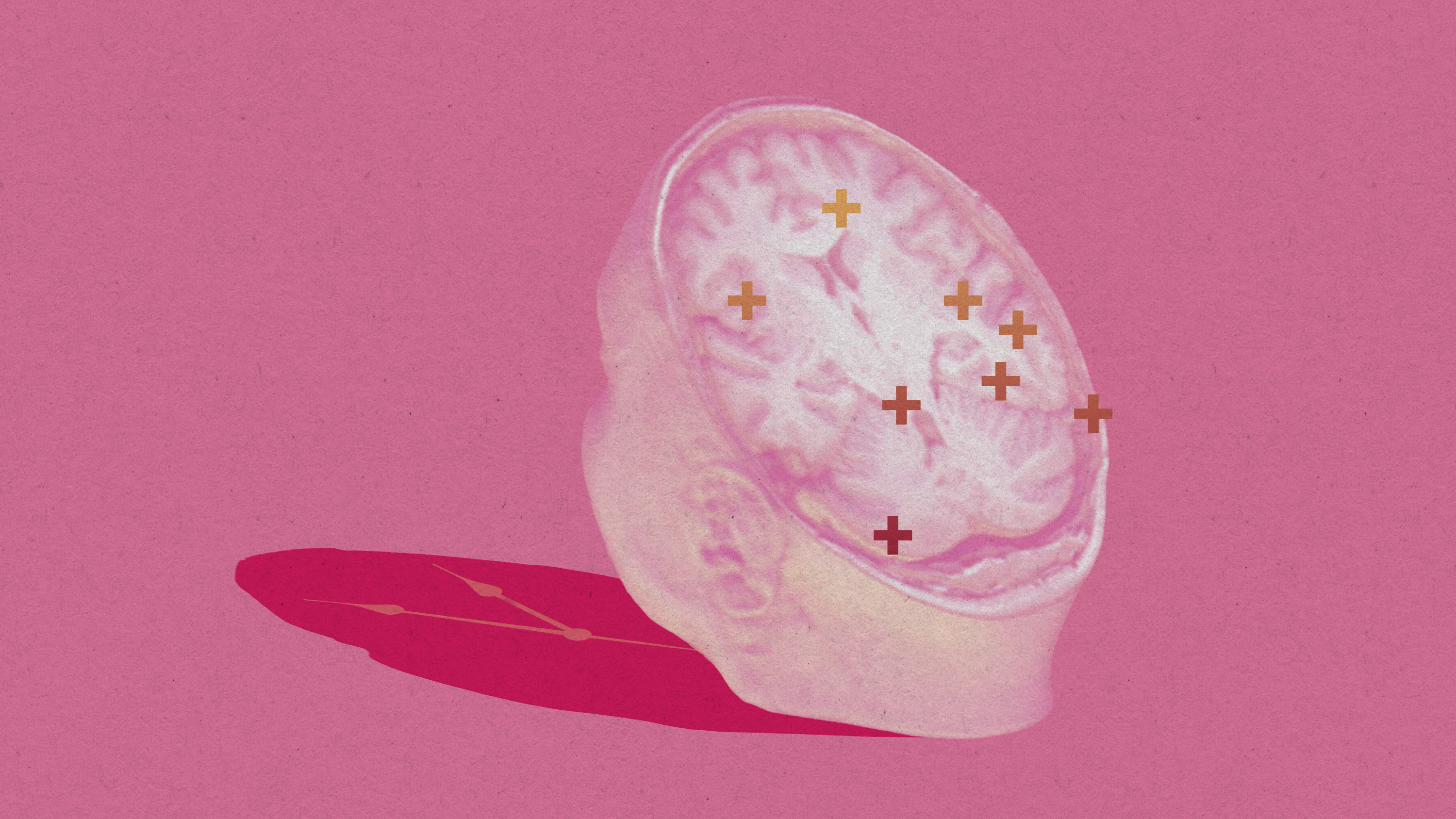Watch a video showing what happens in our brains when we think
Recordings from brain electrodes show "the physical manifestation of thought."

This article first appeared in The Checkup, MIT Technology Review’s weekly biotech newsletter. To receive it in your inbox every Thursday, and read articles like this first, sign up here.
What does a thought look like? We can think about thoughts resulting from shared signals between some of the billions of neurons in our brains. Various chemicals are involved, but it really comes down to electrical activity. We can measure that activity and watch it back.
Earlier this week, I caught up with Ben Rapoport, the cofounder and chief science officer of Precision Neuroscience, a company doing just that. It is developing brain-computer interfaces that Rapoport hopes will one day help paralyzed people control computers and, as he puts it, “have a desk job.”
Rapoport and his colleagues have developed thin, flexible electrode arrays that can be slipped under the skull through a tiny incision. Once inside, they can sit on a person’s brain, collecting signals from neurons buzzing away beneath. So far, 17 people have had these electrodes placed onto their brains. And Rapoport has been able to capture how their brains form thoughts. He even has videos. (Keep reading to see one for yourself, below.)
Brain electrodes have been around for a while and are often used to treat disorders such as Parkinson’s disease and some severe cases of epilepsy. Those devices tend to involve sticking electrodes deep inside the brain to access regions involved in those disorders.
Brain-machine interfaces are newer. In the last couple of decades, neuroscientists and engineers have made significant progress in developing technologies that allow them to listen in on brain activity and use brain data to allow people to control computers and prosthetic limbs by thought alone.
The technology isn’t commonplace yet, and early versions could only be used in a lab setting. Scientists like Rapoport are working on new devices that are more effective, less invasive, and more practical. He and his colleagues have developed a miniature device that fits 1,024 tiny electrodes onto a sliver of ribbon-like film that’s just 20 microns thick—around a third of the width of a human eyelash.
The vast majority of these electrodes are designed to pick up brain activity. The device itself is designed to be powered by a rechargeable battery implanted under the skin in the chest, like a pacemaker. And from there, data could be transmitted wirelessly to a computer outside the body.
Unlike other needle-like electrodes that penetrate brain tissue, Rapoport says his electrode array “doesn’t damage the brain at all.” Instead of being inserted into brain tissue, the electrode arrays are arranged on a thin, flexible film, fed through a slit in the skull, and placed on the surface of the brain.
From there, they can record what the brain is doing when the person thinks. In one case, Rapoport’s team inserted their electrode array into the skull of a man who was undergoing brain surgery to treat a disease. He was kept awake during his operation so that surgeons could make sure they weren’t damaging any vital regions of his brain. And all the while, the electrodes were picking up the electrical signals from his neurons.
This is what the activity looked like:

“This is basically the brain thinking,” says Rapoport. “You’re seeing the physical manifestation of thought.”
In this video, which I’ve converted to a GIF, you can see the pattern of electrical activity in the man’s brain as he recites numbers. Each dot represents the voltage sensed by an electrode on the array on the man’s brain, over a region involved in speech. The reds and oranges represent higher voltages, while the blues and purples represent lower ones. The video has been slowed down 20-fold, because “thoughts happen faster than the eye can see,” says Rapoport.
This approach allows neuroscientists to visualize what happens in the brain when we speak—and when we plan to speak. “We can decode his intention to say a word even before he says it,” says Rapoport. That’s important—scientists hope technologies will interpret these kinds of planning signals to help some individuals communicate.
For the time being, Rapoport and his colleagues are only testing their electrodes in volunteers who are already scheduled to have brain surgery. The electrodes are implanted, tested, and removed during a planned operation. The company announced in May that the team had broken a record for the greatest number of electrodes placed on a human brain at any one time—a whopping 4,096.
Rapoport hopes the US Food and Drug Administration will approve his device in the coming months. “That will unlock … what we hope will be a new standard of care,” he says.
Now read the rest of The Checkup
Read more from MIT Technology Review's archive
Precision Neuroscience is one of a handful of companies leading the search for a new brain-computer interface. Cassandra Willyard covered the key players in a recent edition of the Checkup.
Brain implants can do more than treat disease or aid communication. They can change a person’s sense of self. This was the case for Rita Leggett, who was devastated when her implant was removed against her will. I explored whether experiences like these should be considered a breach of human rights in a piece published last year.
Ian Burkhart, who was paralyzed as a result of a diving accident, received a brain implant when he was 24 years old. Burkhart learned to use the implant to control a robotic arm and even play Guitar Hero. But funding issues and an infection meant the implant had to be removed. “When I first had my spinal cord injury, everyone said: ‘You’re never going to be able to move anything from your shoulders down again,’” Burkhart told me last year. “I was able to restore that function, and then lose it again. That was really tough.”
A couple of years ago, a brain implant allowed a locked-in man to communicate in full sentences by thought alone—a world first, the researchers claimed. He used it to ask for soup and beer, and to tell his carers “I love my cool son.”
Electrodes that stimulate the brain could be used to improve a person’s memory. The “memory prosthesis,” which has been designed to mimic the way our brains create memories, appears to be most effective in people who have poor memories to begin with.
From around the web
Do you share DNA with Ludwig van Beethoven, or perhaps a Viking? Tests can reveal genetic links, but they are not always clear, and the connections are not always meaningful or informative. (Nature)
This week marks 79 years since the United States dropped atomic bombs on Hiroshima and Nagasaki. Survivors share their stories of what it’s like to live with the trauma, stigma, and survivor’s guilt caused by the bombs—and why weapons like these must never be used again. (New York Times)
At least 19 Olympic athletes have tested positive for covid-19 in the past two weeks. The rules allow them to compete regardless. (Scientific American)
Honey contains a treasure trove of biological information, including details about the plants that supplied the pollen and the animals and insects in the environment. It can even tell you something about the bees’ “micro-bee-ota.” (New Scientist)
Deep Dive
Biotechnology and health

This researcher wants to replace your brain, little by little
The US government just hired a researcher who thinks we can beat aging with fresh cloned bodies and brain updates.

Aging hits us in our 40s and 60s. But well-being doesn’t have to fall off a cliff.
Lifestyle changes could counter some of the deterioration.

Beyond gene-edited babies: the possible paths for tinkering with human evolution
CRISPR will get easier and easier to administer. What does that mean for the future of our species?

A new law in California protects consumers’ brain data. Some think it doesn’t go far enough.
Tech companies collect brain data that could be used to infer our thoughts—so it’s vital we get legal protections right.
Stay connected
Get the latest updates from
MIT Technology Review
Discover special offers, top stories, upcoming events, and more.